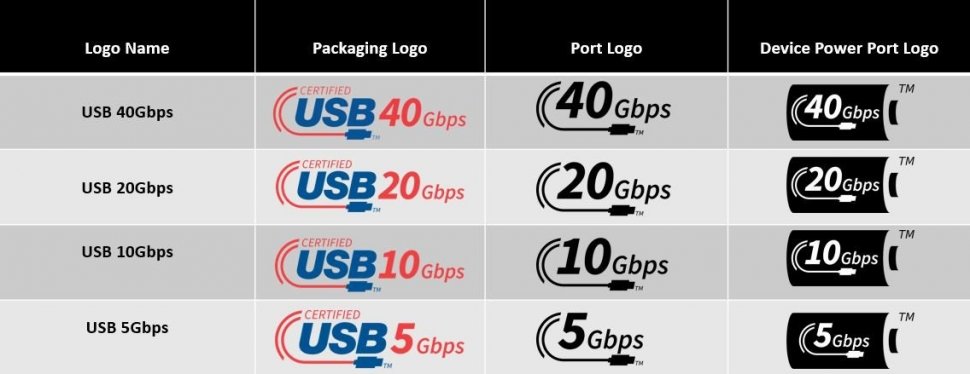Finally clarity with USB-C? With new logos against the USB chaos


The USB Implementers Forum has unveiled new logos that manufacturers can print on packaging to make it clear what each USB connector is capable of. There are also new signets for USB-C.
In 2019, the USB Implementers Forum officially presented the USB 4.0 standard. This should finally put an end to the very confusing chaos of names with USB. The promise did not last long, because USB4 Version 2.0 was officially announced in September 2022. The data rate is to be doubled to 80 Gbps, even if precise technical data, let alone chipsets, with the new connection are still missing. However, the new name brings back memories of USB 2.0. In any case, USB4 only comes with a USB-C connector. However, there can be a connection with different features. With new logos, it should become clearer what the built-in port is capable of doing. The new logos apply not only to the USB-C connection type, but also to USB-A type USB connections.
New naming scheme and new logos
In a message dated USB Implementers Forum will have new signets presented that manufacturers can use. However, the new logos will not become mandatory, so there is a risk that there will only be a small amount of packaging with the label. Instead of names like USB 3.2 or USB4, the new designations are based on the maximum data rate. For example, the designation for the full expansion of USB4 is now USB40 Gbps, while USB 3.0 will be called USB5 Gbps in the future. Next to a black and white logo printed directly onto the cable or the device, there is a blue and red sign for the device’s packaging. If the USB port can also charge devices via USB-PD in addition to data transfer, the designation resides in a stylized battery.
In connection with a USB-C cable, the logo also provides information about the maximum wattage that the cable can transmit in addition to the data rate. Hi-Speed USB Cables are USB-C charging cables that can also transfer USB 2.0 data at a maximum of 480 Mbit/s. It is doubtful whether the new logos will really make it clearer what a USB-C port can do. Finally, there is also an expansion stage with Thunderbolt 4, which then also masters USB4. The problem is that there is no obligation for manufacturers to use the new logos. As the USB-IF recommends, in the future consumers should only buy USB-C cables that have the appropriate logo to avoid unpleasant surprises. From mid-2024, a USB-C charging port will be mandatory for every new portable electronic product large enough for a USB-C port that appears in the EU. In return, device manufacturers can then refrain from including a suitable USB charging cable in the packaging.
Also worth reading: It’s official: The EU has a uniform standard for charging cables
New USB logos collection:
- The USB Implementers Forum has presented new logos for USB connectors and USB-C cables. In the future, designations such as USB4 or USB 3.2 will be passe, instead the names are based on the maximum data rate that the built-in port can deliver.
- For example, the full expansion of USB4 becomes the name USB40 Gbps, since 40 Gbps of data can be transferred.
- USB-C cables have logos that contain not only the data transfer rate but also the maximum wattage. However, there is also the Hi-Speed USB Cable, which only means a transfer speed of USB 2.0 speed.
- Although the USB-IF would like to convey clarity with the new logos, the device manufacturers can decide for themselves whether they want to print the new logs on the packaging or the device.
Source: USB IF
Reference-www.pcgameshardware.de